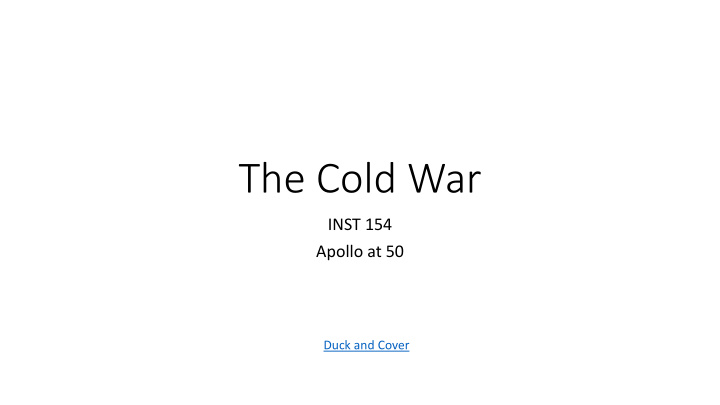



The Cold War INST 154 Apollo at 50 Duck and Cover
Origins of the Cold War • Truman (April 1945-January 1953) • Potsdam Conference (July 1945) • Atomic bombing of Hiroshima and Nagasaki (August 1945) • United Nations (October 1945) • Strategy: Containment (February 1946) • Truman Doctrine (March-May 1947) • Marshall Plan (April 1948) • Berlin Airlift (June 1948) • NATO (April, 1949) • Soviet atomic test (August 1949) • “Loss of China” (October 1949 to May 1950) • Korean War (June 1950) • Chinese entry into the Korean War (October 1950) • MacArthur relieved of command for insubordination (April 1951)
Early Cold War • Eisenhower (January 1953-January 1961) • Strategy: Massive Retaliation • 15 megaton US hydrogen bomb test (March 1954) • Warsaw Pact (May 1955) • “Airborne alert” bombers (September 1958) • U-2 shootdown (May 1960) • Kennedy (January 1961-November 1963) • Strategy: Flexible Response • Bay of Pigs invasion (April 1961) • Berlin Wall (August 1961) • Cuban Missile Crisis (October 1962) • Johnson (November 1963-January 1969) • Strategy: Mutually Assured Destruction • Vietnam War (August 1964)
Nuclear Weapons
Peenemunde
Operation Paperclip (1945-1952)
Operation Osoaviakhim (Oct 1946)
Vostok-R7
Mercury- Redstone
Mercury- Atlas
Gemini- Titan II
The “Readings” • Gaddis Chapter 2 (“Deathboats and Lifeboats”) • Learning to manage nuclear weapons • McDougall Chapter 12 (“The Missile Bluff”) • Development of ICBM’s and international law on use of outer space • Chertok Volume 3 Chapter 1 (“The Cold War”) • The Cold War as seen from OKB-1 on the Soviet Union • Fail Safe (motion picture) • Shaping public thinking about nuclear weapons after the Cuban Missile Crisis
Activity: Case Study Selections • By role: • Managers, contractors, astronauts, engineers, operations, support, scientists, politicians, media, Soviet Union, other public figures • By background: • Gender, race, social class, national origin, …
Case Study Process • Selections due before class on September 10 on ELMS • At least five from different categories, in preference order • We will select from these and make assignments • Read the initial reading (usually an oral history) • May need to use the Internet Archive is the JSC Oral History site remains down • Find additional primary and secondary sources • Internet text/video/audio, books (allow time for interlibrary loan!), journals • Select a vignette and write about it • Background, role(s), one vignette , post-Apollo career • 2-3 pages, single-spaced, standard margins, 12-point font (plus references)
Recommend
More recommend